HD560 Ovation II
back to Sennheiser
back to measurements
home
published: July-25-2021, updated: Dec-13-2021
NO SMOOTHING is applied to the shown plots. Most measurement sites have some smoothing applied which ‘irons flat’ sharp peaks and ‘wiggles’. I do not use smoothing because some info about sound quality is lost when plots are smoothed.
Aside from a small correction of the microphone itself also some correction in the lowest frequencies is applied to the plots to compensate for the perceived loss of bass when using headphones. This is described HERE in more detail.
A ‘horizontal‘ frequency response curve on the shown frequency response plots on this website thus indicates a perceived ‘flat’ tonal signature.
ALL measurements are made with a good SEAL on a flatbed measurement rig.
The shape of your head, bone structure, pad size, pad ‘softness, (compliance), hair or no hair and or wearing glasses may (drastically) change the frequency response of some headphones, so… your personal experience may differ substantially from these plots.
Frequency response (tonal balance) is the most sound-determining aspect of headphones. A horizontal line shows audible neutral response in the plots on this website. Deviations in different severities at different frequency bands have an effect on the sound character.
The bigger the deviation the stronger the effect.
Below an aid to help determining the sound character of headphones with relation to the frequency response.

Sennheiser HD560 Ovation II

The Sennheiser HD 560 Ovation II is an open over-ear headphone. When this headphone came out (1993) it sold for around € 170.-.
It was part of series of headphones HD 520 II ~ HD 530 II ~ HD 540 Reference II ~ HD 560 Ovation II ~ HD 580 Precision and the closed version HD 250 Linear II.
The 3m long cable is connected via the familiar 2-pin Sennheiser plugs in each cup. The long cable indicates that this headphone is primarily intended for home/desktop usage. The cable has a 3.5mm plug with a 6.3mm adapter.
The cable is not microphonic so in quiet passages and silences the cable rubbing against clothes is barely audible in the left cup.
The headband is very simple in construction and has a sliding construction for the strap. The cups can swivel and tilt. Also he headband itself is very flexible so this will fit most head sizes. Clamping force is pleasantly low (2.5N) and so is its weight of 210 gram.
The velour pads are exchangeable and still feel firm enough and look good. The original pads are no longer available but there are plenty of after-market pads.
One does NOT have to worry about seal being essential for bass reproduction.
With a sensitivity of around 94dB/mW and 300Ω impedance 99dB/V the HD560 should not be used directly from a phone and reach high enough levels for normal music listening. To reach impressive levels it needs a bit more voltage than a phone, tablet or USB dongle. This headphone is not very sensitive so requires an amplifier to reach higher listening levels. It is about 5dB less sensitive than the HD600/HD650.
The driver is based on the, still used, HD600/HD650 frame. The membrane differs from the HD580/HD600/HD650.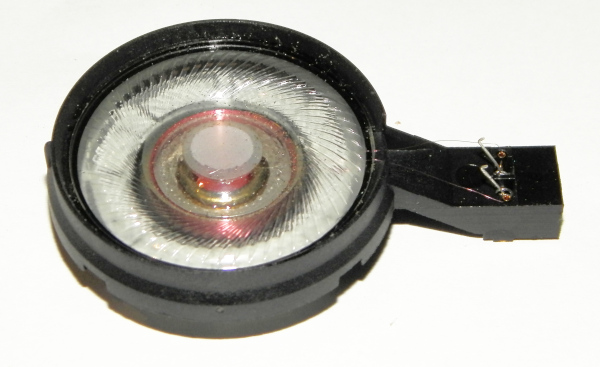 The HD560 Ovation II driver has a sticky material on top of the dome. Also the plastic seems more transparent. I got this headphone for a good price because the left side was afflicted with the familiar problem. A poor contact with the metal springs that make contact with the connector. Taking the springs out and stretching the outer parts of the spring and reinserting the spring (Tyll made a video about replacing the springs) helps. Replacement is not really needed. One needs to be very careful not to break the extremely thin voice-coil wires that go into a gold-plated bushing the springs make contact with.
The HD560 Ovation II driver has a sticky material on top of the dome. Also the plastic seems more transparent. I got this headphone for a good price because the left side was afflicted with the familiar problem. A poor contact with the metal springs that make contact with the connector. Taking the springs out and stretching the outer parts of the spring and reinserting the spring (Tyll made a video about replacing the springs) helps. Replacement is not really needed. One needs to be very careful not to break the extremely thin voice-coil wires that go into a gold-plated bushing the springs make contact with.
specifications:
Type: Over ear, open
Usage: Home, studio
Driver type: dynamic
Pads: replaceable, velours
Collapsible: No
Headphone cup connector: 2x marked Sennheiser 2-pin connector.
Cable entry: dual sided.
Cable: 3m terminated in a 3.5mm TRS jack with a 6.3mm adapter
Driver size: 38mm (36mm membrane)
Inner Pad dimensions: diameter = 60mm, depth = 19mm
Max. power rating: 0.2W
Max. voltage: 7.8Vrms (22Vpp)
Max. current: 26mA
Max. S.P.L.: 117 dB
Impedance: 300 Ω (measured)
Efficiency: 94dB @ mW
Sensitivity: 99dB @ V
Weight: 210 g. (excl. cable)
Clamping force: low (2.5N)
Subjective sound description:
Bass is lean but not particularly lacking. Deep rumbles are nowhere to be found. Mids are neutral, clear and dynamic and a bit ‘forward’. Treble is present and especially the top end is elevated but does not sound coarse nor grainy/gritty. Because of the elevated treble this headphone sounds overly detailed. For classical music this sounds fine but other genres may have some sharpness to the sound. Seeing this headphone is about 30 years old it is surprising to hear that, aside from the sub-lows, this headphone can still compete with many current headphones.
Measurements:
Below the frequency response of the HD 560 Ovation II (Left, Right)
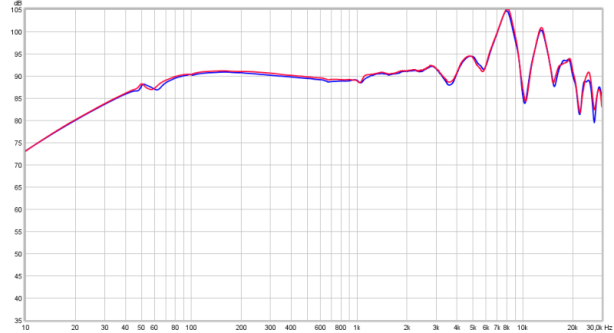
The channel matching is excellent.
Bass is not well extended but present and does not feel ‘lacking’ and rolls off very gently below 70Hz. From 100Hz to 4kHz the response is linear and gently sloping (neutral signature). The human voice spans from 100Hz to 3kHz so voices sound neutral. At 8kHz there is a +15dB peak which makes voices sound ‘sharp’ and overly detailed. Some people like this but those that are sensitive in this part of the frequency range won’t be amused for long. At 10kHz there is a dip followed by another peak of +10dB at 13kHz. Treble extension is excellent and extends beyond 30kHz.
comparisons
Below a comparative measurement of the HD560 Ovation II compared to the current HD600.
Bass, lows and mids are very similar to the HD600. Above 1.5kHz the HD560 Ovation II has more presence. When one considers that many folks already find the HD600 too clear and forward it is evident that the HD560 Ovation II is even clearer sounding. The biggest difference, however, is above 4kHz where it is clear that Sennheiser made quite a few steps with regard to damping higher frequencies. The HD560 Ovation II has a substantial treble peak.
Not unlike that of the Beyerdynamic DT1990 (A-pads) shown below.
Below the HD560 Ovation II compared to the Beyerdynamic DT1990-A.
Bass extension of the DT1990-A is much better. Linearity from 50Hz to 2kHz is very similar. The Beyer treble peak is already infamous, that of the HD560 Ovation II is even 5dB ‘worse’.
Below the HD560 Ovation II versus the well known HD650
The HD650 is better extended in the lows and has a bit more ‘warmth’. Treble quality (or should I say quantity) of the HD650 is at the proper level. Those that find the HD650 too ‘warm’ and too subdued in the treble may well like the HD560 Ovation II (and most likely also the HD540 Reference II) better.
Below the HD560 Ovation II versus the headphone with the same name HD560S
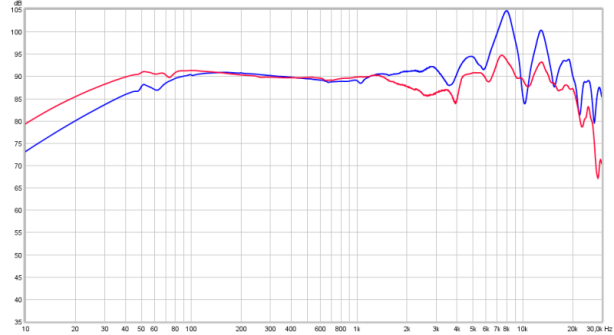
HD560S has 1 octave lower bass extension (25Hz opposite 50Hz @ -3dB) and is lacking the extreme peak but it does have a peak at 7.5kHz but just +5dB. Linearity between 100Hz and 5kHz is about the same. The HD560S appears to be lacking in the 3kHz range but these headphones were measured on a flat-plate test fixture without pinna. Due to the HD560S driver being angled (HD560 Ovation II is not) there is some pinna gain in that area which is not shown in the plot.
Phase response
Below the phase response of the HD560 Ovation II (Left, Right)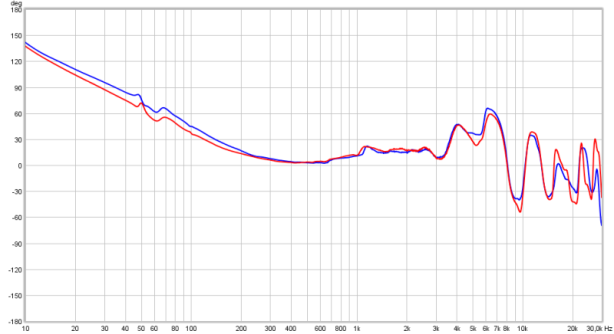
Gentle sloping phase is not audible. Above 6kHz the phase changing within a narrow frequency band is more problematic and shows there are resonances in that area. Pad-bounce (65Hz) is minimal.
output resistance / damping-factor
As this is a dynamic headphone the frequency response can be amplifier output resistance dependent when certain higher output resistance amplifiers are used.
Instead of showing impedance plots, which are hard to ‘read’ when it comes to assessing the tonal balance change in the real world, the HD560 Ovation II is measured via a few different resistance outputs (0.2Ω, 10Ω, 33Ω and 120Ω). On a higher output resistance amplifier the output level will be lower of course due to voltage division. To compensate for this the amplifier is cranked up to the same level (2.9dB for 120Ω at 1kHz in this case). This way the plots are overlaid and it is easier to see how the tonal balance changes. Output resistances between the mentioned resistance values will result in tonal changes between those traces.
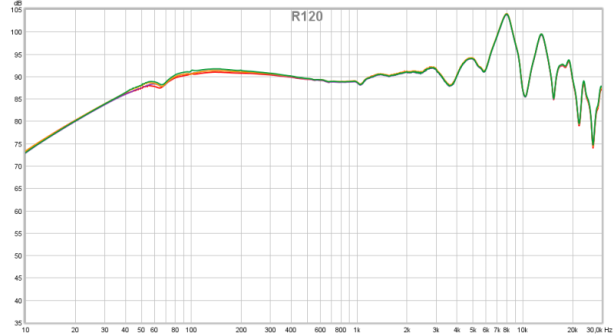
The tonal balance hardly changes when the HD560 Ovation II is connected to a higher output resistance amplifier. The resonance frequency is around 100Hz resulting in a just very slightly warmer sound.
seal
Seal can be an issue with closed-back headphones but is usually less of a problem for open headphones. Breaking the seal (improper fit on the head) usually means a loss of (sub)bass. Perfect seal, seal broken with a thick arm pair of glasses and seal substantially broken by slightly lifting the bottom of the pads which can occur when not properly seated.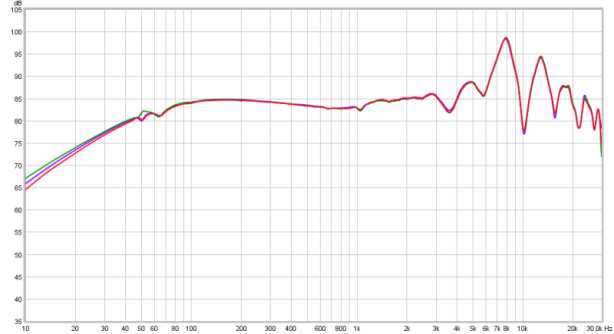
The HD560 Ovation II is insensitive to a seal breach. People wearing glasses are greeted with the same amount of lows as the ones with a perfect seal.
Below the distortion measurements of the HD560 Ovation II (Right channel).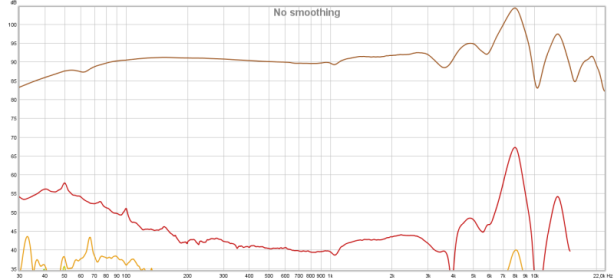
The plot above shows the level differences between the signal (upper trace around 90dB SPL) and the harmonics. Most people prefer to see percentages instead of level differences so below the exact same plot except ‘normalised’ to the actual signal and level differences given in percentages.
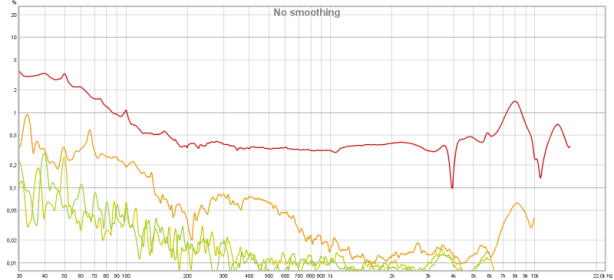 Distortion levels in the lowest frequencies are mainly 2nd harmonic above 200Hz distortion drops below 0.5% which is good for a driver of this size.
Distortion levels in the lowest frequencies are mainly 2nd harmonic above 200Hz distortion drops below 0.5% which is good for a driver of this size.
The actual 2nd harmonic distortion above 1kHz may well be lower than 0.3% . A shortcoming of my measurement rig.
Below the CSD (waterfall) plot of the HD560 Ovation II . (Left and Right are overlaid)
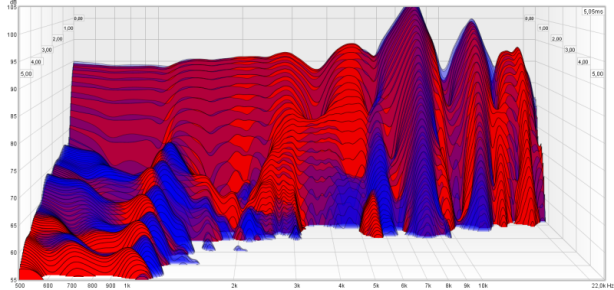
Below 1kHz damping is not that great. The resonance at 8kHz is high but fortunately short lived. So is the resonance at 13kHz. This is great as EQ will work fine.
Below the Group Delay plot for the HD560 Ovation II (Left, Right)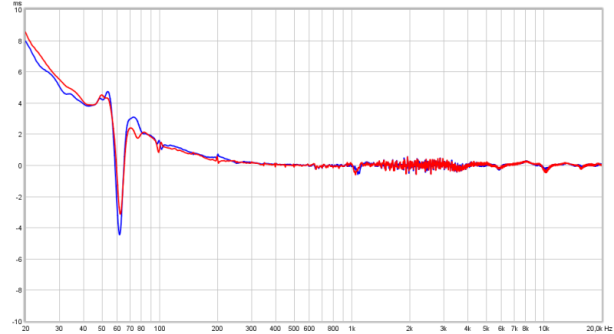
There is some pad bounce at 60Hz, otherwise no surprises here. The 8kHz, 10kHz and 13kHz peaks and dips (resonances) aren’t really visible in the group delay plot.
A different plot is the spectrum plot. This basically is a CSD (Waterfall) plot but viewed from above where the level differences are colour coded instead of being in the vertical axis. Also the frequency range of the spectrum plot is wider (from 100Hz instead of 500Hz). The time span is also bigger in the spectrum plots and expired time is shown from below to top where in the CSD the time is shown from rear to front.
Below the spectrum plot of the HD560 Ovation II (Right channel)
No alarming issues here either.
Step response
Below the step response plot which, when the sound is balanced and well extended should show a rise to around 0dB, (indicating fast driver response) and should be slightly sloping downwards indicating bass extension. (Left, Right)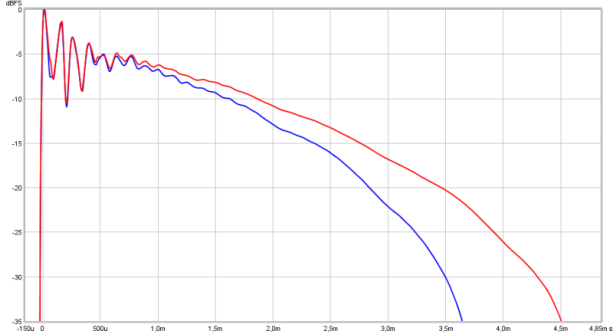
The lack of deep bass extension is visible as the horizontal trace drops quickly after 1ms. The ragged and elevated part in the first 500μs shows the sharp and elevated upper treble.
square-wave and impulse response
Below 40Hz and 440Hz square-waves and 100μs impulse response, stimulus (and target) and measured response.
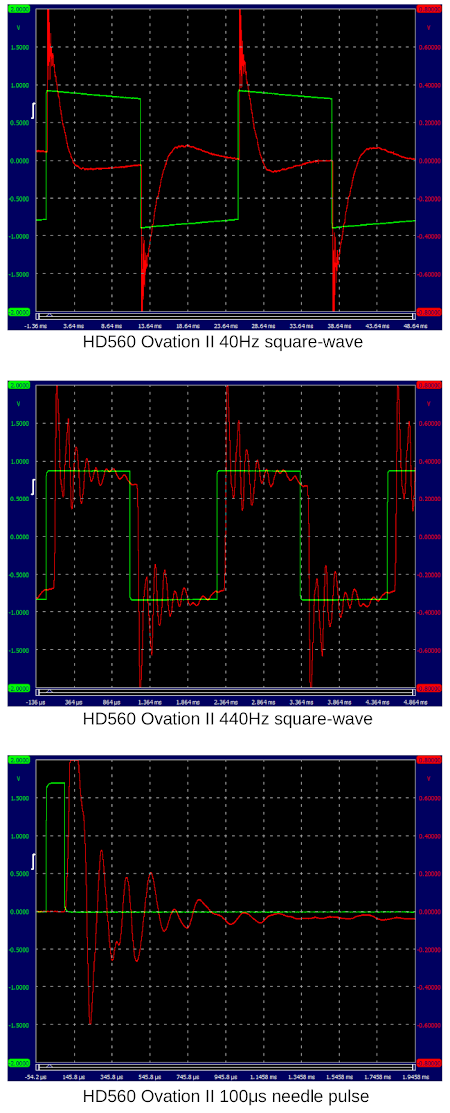 Bass roll-off and a whole lot of ringing going on.
Bass roll-off and a whole lot of ringing going on.
reducing the treble
To reduce the treble (but not the 3kHz peak) some experiments were done using toilet paper.
With 2 plies of toilet paper the treble extension started to suffer and lower mids began to become less neutral and did not remove the 8kHz peak nearly enough.
I ended up with just one ply of 2-ply toilet paper.
This lowered the 13kHz the proper amount but hardly affected the 8kHz peak. A passive filter lowered the 8kHz peak perfectly but the 13kHz peak remained problematic.
A combination of both methods worked excellent. The modification is very easy to do and totally reversible. It requires pulling off the pads and the foam disc. Underneath there is a kind of cloth/paper ring partly covering the driver. This too must be taken off (sits loosely on the driver).
Cut a ply of 2-ply toilet paper to a round disc roughly the size of the driver part. Pull the 2 plies apart so you end up with 2 small discs of thin toilet paper (approx. 40mm Ø) and lay it on the driver as shown below.
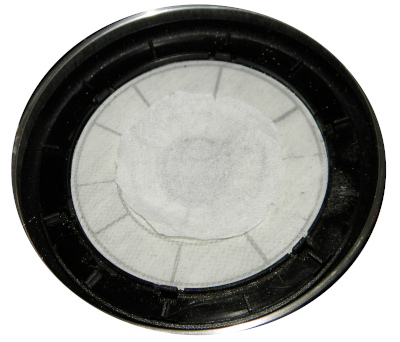 Put the cloth/paper ring on it. This will keep the toilet paper it in its place. Put the foam disc on top of it and push the ear-pads back in place.
Put the cloth/paper ring on it. This will keep the toilet paper it in its place. Put the foam disc on top of it and push the ear-pads back in place.
The filter schematic is posted below. This filter can also be ordered here.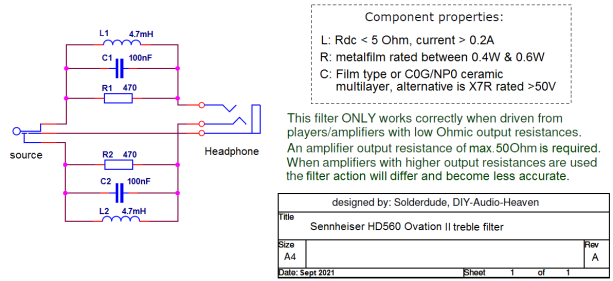
Below some measurements. Stock, 1 ply of toilet paper only, 1 ply + passive filter.

The toilet paper lowers the 13kHz peak but also makes the bass roll-off a bit steeper. The midbass (150Hz is increased just slightly. The filter completely removes the 8kHz treble peak and also the 4kHz peak is lowered a bit.
Below the modified + filtered HD560 Ovation II versus the HD600.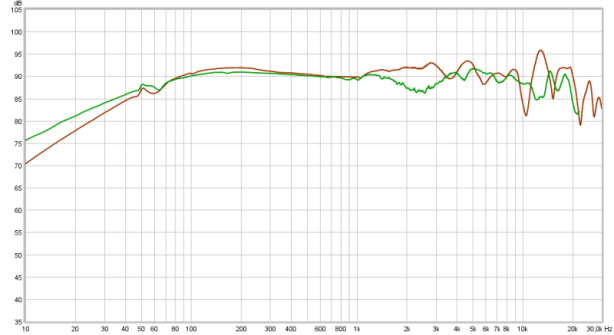
The treble peak is removed and it is closer to the HD600 in tonal balance.
Below the frequency response of the modified + filtered HD560 Ovation II (Left, Right)
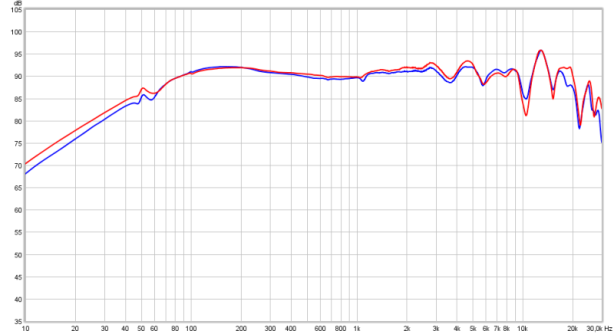
And the CSD of the improved HD560 Ovation II (Left, Right)
Above 1.5kHz the CSD looks pretty good.
Also the phase response improved a bit. Only around 11kHz the phase still jumps 60°. The 180° phase shift at 8kHz is removed by the filter.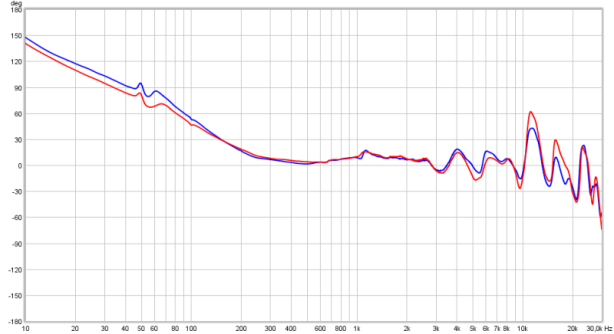
square-wave and impulse response
Below 40Hz and 440Hz square-waves and 100μs impulse response of the filtered HD560 Ovation, stimulus (and target) and measured response.
 The filter is very effective in removing the resonance. Both the 440Hz and 100μs impulse response are very good (close to exemplary for a headphone).
The filter is very effective in removing the resonance. Both the 440Hz and 100μs impulse response are very good (close to exemplary for a headphone).
Conclusion
HD560 Ovation II is an old headphone which one sometimes can find second hand. This one along with the HD545 are still some good sounding headphones even today.
The headphones are comfortable and lightweight. These models are sometimes plagued with one or both channels cutting out when wiggling the connectors. When you’re handy fixing the spring contacts isn’t rocket science (but must be done carefully).
With the treble peaks removed this headphone sounds excellent. Without these modifications these headphones sound good with most classical music.
The impedance is high (300 Ω) and its efficiency is low (99 dB/V). This means it is not very usable driven from a phone, tablet or small dongle or DAP. It needs some amplification. Output resistance is no issue so no problem driving this headphone from headphone out sockets of receivers and tube headphone amplifiers.
The headphone reacts fairly well to EQ so some of the lacking subbass can be lifted as well.

bonjour
j’ai un OVATION HD560 et je cherche les mousses des oreilettes. Ceux du OVATION 2 se montent il dessus? Merci de votre reponse
Both HD560 Ovation and Ovation II use the same pads. Sennheiser article No. 041299
I have a pair of HD560 Ovation II that I bought new in 1994 and are still my main headphones to this day. I’ve replaced the pads with original Sennheiser pads 3 times since I’ve bought them, each pair of pads lasting between 8-9 years. They are indeed very good for classical music, which they were actually marketed for when they came out. I had a NAD 701 receiver which was very warm sounding, so it helped to warm up and reduce the treble of the HD560 quite well. I was a big classical music listener, so I always found the HD560 excellent for this style of music. Other than that, I just eq down the treble a little when listening to pop/rock, but I’ve gotten so used to their sound signature that I’m comfortable with them as they are. I’m sad the original pads have been discontinued and will probably have to by myself a different pair in the future.
This is my 30th year with this amazing headphone. I’ve tried the 600/650 and HD 700 from senn but I’ve always come back to my beloved 560 II’s. I have one pair of stock ear pads unopened left. They stopped selling all parts now for this model prob since the stupid buyout. But I last emailed them in 2021 and they were still selling them at that time but now in April 18th 2023 they no longer support any of it’s parts.
Anyway I’ve never heard a more detailed headphone in my life. I pair it with a bottlehead crack and an ifi black label. And with the ifi black label with it’s sub boost turned up it takes the HD 560 II’s to Perfection. It adds perfectly the bass it lacks and warms up the sound like nothing else. I use the ifi out to the bottlehead crack via it’s rca jacks sometimes too. If I ever get to point I can’t upgrade the cables or pads I’ll leave the hobby for good. My heart belongs to the HD 560 Ovation II’s